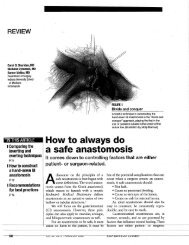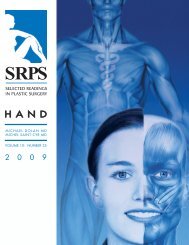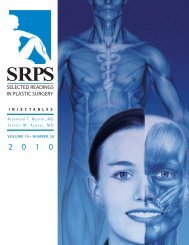Craniofacial Anomalies, Part 2 - Plastic Surgery Internal
Craniofacial Anomalies, Part 2 - Plastic Surgery Internal
Craniofacial Anomalies, Part 2 - Plastic Surgery Internal
You also want an ePaper? Increase the reach of your titles
YUMPU automatically turns print PDFs into web optimized ePapers that Google loves.
traces the patients’ course over a maximum of 12<br />
years of recurrence-free follow-up.<br />
V — UNCLASSIFIED<br />
A few rare anomalies do not fit into the first four<br />
categories and are best placed in this last category.<br />
They should be described based an the organ or<br />
organs involved. Examples include aglossia or macroglossia,<br />
anotia,and ocular anomalies such as<br />
epicanthal folds. 10<br />
CRANIOMAXILLOFACIAL SURGERY<br />
HISTORY<br />
The origin of craniofacial surgery can be traced as<br />
far back as 1890, when Lannelongue and Lane performed<br />
the first craniotomies, 362,363 but it was not<br />
until the First and Second World Wars that numerous<br />
battle casualties stimulated the development of<br />
techniques for the replacement of missing bone and<br />
soft-tissue of the face, and set the stage for attempts<br />
in the 1940s and ’50s to correct congenital facial<br />
deformities.<br />
Waterhouse 364 reviews the history of craniofacial<br />
surgery with particular emphasis on the contributions<br />
by Le Fort, Virchow, Gillies, and Tessier. In<br />
1951 Gillies and Harrison 365 reported the first successful<br />
Le Fort III advancement osteotomy for correction<br />
of midfacial retrusion in a patient with<br />
Crouzon syndrome. The operation was technically<br />
very complex and only partially successful in correcting<br />
the exorbitism, because it carried the osteotomy<br />
in front of the orbital rim, lacrimal sac, and medial<br />
canthal ligament. In 1962 Converse and Smith 366<br />
described an operation to correct hypertelorism based<br />
on their experience with malunited nasoorbital fractures<br />
with telecanthus.<br />
Paul Tessier is regarded by most clinicians as the<br />
father of craniofacial surgery. After years of careful<br />
study with many of the most innovative maxillofacial<br />
surgeons of his time and numerous hours spent in<br />
the laboratory doing cadaver dissections, Tessier proposed<br />
a novel method of facial osteotomies and<br />
wholesale mobilization of bone for operating on<br />
patients with deformities of the craniofacial skeleton.<br />
Tessier pioneered the intracranial approach for the<br />
correction of hypertelorism, worked closely with<br />
neurosurgeons to resect difficult craniofacial tumors,<br />
SRPS Volume 10, Number 17, <strong>Part</strong> 2<br />
was first to manipulate cranial bones in the treatment<br />
of patients with craniosynostoses, and performed<br />
successful Le Fort III operations in difficult<br />
cases of Apert and Crouzon syndrome. In 1967<br />
Tessier 367 presented this work at the Fourth International<br />
Congress of <strong>Plastic</strong> and Reconstructive <strong>Surgery</strong><br />
in Rome, and the new field of craniofacial surgery<br />
was launched.<br />
Two principles fundamental to the practice of<br />
craniomaxillofacial surgery emerged from his discussion:<br />
(1) large segments of the facial and cranial skeleton<br />
can be completely denuded of their blood supply,<br />
repositioned, and yet survive completely; and<br />
(2) the eyes can be translocated horizontally or vertically<br />
over a considerable distance without impairing<br />
the vision.<br />
Tessier’s results in the late ’60s and early ’70s<br />
proved conclusively that most skeletal deformities of<br />
the face and calvarium can be corrected or at least<br />
significantly improved by appropriate surgical<br />
maneuvers. The importance of his work to the<br />
intracranial correction of hypertelorism 368–370 cannot<br />
be overemphasized. Along with Converse’s onestage<br />
procedure, it is the backbone of present-day<br />
techniques for hypertelorism correction.<br />
Basing his approach on Le Fort’s anatomic research<br />
with cadaver skulls, 371 Tessier developed the Le Fort<br />
III osteotomy for facial advancement and presented<br />
his results in 1971. His experience encompassed<br />
151 patients representing almost 500 individual malformations<br />
of the cranial and facial region. Tessier’s<br />
contributions to craniofacial surgery were reviewed<br />
in Rome in 1982 on the occasion of the 15th anniversary<br />
of Tessier’s original presentation. 372<br />
The advent of plate-and-screw fixation after<br />
maxillary and mandibular osteotomies has been<br />
of tremendous benefit to the management of congenital<br />
as well as traumatic cases of craniomaxillofacial<br />
deformity. Rigid fixation has dramatically<br />
enhanced the stability of bony fragments,<br />
improved primary bone healing, and eliminated<br />
the need for prolonged maxillomandibular fixation<br />
in the older patient. 373–378<br />
The fate of microfixation hardware during rapid<br />
calvarial growth in infants and young children has<br />
been questioned. Munro and colleagues 379 acknowledge<br />
intracranial “migration” of microplates and<br />
screws. Goldberg and colleagues 380 report cases of<br />
children undergoing revisional surgery who were<br />
found to have microscrews and plates lying beneath<br />
33






